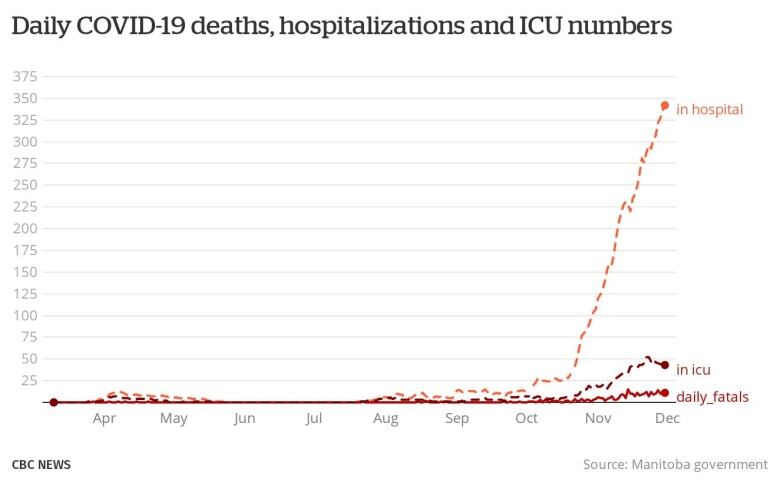Manitoba flattens the curve again, albeit at an unacceptable height
Daily COVID-19 case counts are no longer increasing. Now they have to drop dramatically

Almost three weeks after all of Manitoba was placed under code red pandemic restrictions, there's been almost no change in the number of COVID-19 cases announced each day.
On Nov.12, the day new public health restrictions went into effect for the entire province, the average case count over a one-weekperiod ending on that fateful Thursday was 373 per day.
On Nov. 30, the seven-day average case count was 392 per day.
There is little statistical difference between those counts. Manitoba has effectively flattened the COVID-19 curve once again albeit at a level nobody wants to see.
Manitoba finds itself occupying a pandemic altitude more akin to theTibetan Plateau, perched high atop the Himalayas, than the nearly sea-level expanses of the Red River Valley or Hudson Bay Lowlands.
There are a number of ways to look at this plateau. Dr. Brent Roussin, Manitoba's chief provincial public health officer, takes some solace from the fact daily case counts are no longer growing the way they did throughout October and intoNovember.
"We haven't seen that escalation," Roussin said during his Monday press briefing. "We had models putting us nearer a thousand cases a day right now, without any intervention. So it's certainly having an effect."
That's the good news. The bad is a daily case count of just under 400 is far above a level the health-care system can withstand for many more days.
Conservative projections still troubling
The reason for this is simple math. For every 100 new COVID-19 cases, Manitoba hospitals can expect to treat six new patients, one ofwhom will require intensive care.
Over the past week alone, Manitoba announced 2,738 new COVID cases.That translates to another 164patients requiring hospitalization, including 27 more requiring intensive care.
These are conservative ratios.Nonetheless, even conservative projections spell trouble for Manitoba hospitals. As of Monday, 342 COVID-19 patients occupied hospital beds, including 43 patients in the intensive care unit (ICU).
That ICU number does not include long-term COVID-19 patients who are no longer contagious but still require ventilation. Manitoba's COVID-19 ICU statistic only counts patients in hospital for fewer than 30 days.
Regardless, hospitals were already struggling Monday to managethe 105 Manitobans both those with and without COVID-19 who require intensive care. There's a limited pool of nurses, doctors and other health-care professionals who possess the knowledge to care for ICU patients.

Caring for an ICU patient is not like placing a pizza pop in a microwave and waiting for the console to beep. Intensive-care patients mustbemonitored frequently for life-threatening variations in oxygen levels, heart rate,blood pressure, blood chemistry and other measures that may require immediate pharmaceutical or physicalintervention.
A relatively small pool of skilled workers are being rotated throughnerve-rackingICU shifts that nowinvolvemore patients to monitor at once.
This high wire act has become "difficult for our staff, many of whom are putting aside their own fears to work long hours in stressful environments," Chief Nursing Officer Lanette Siragusa said Monday.
"The bottom line is our health system is at risk of being overwhelmed if we can't reduce these daily case counts."
On the off chance some Manitobans are still wondering what that means, Siragusa is stating the obvious: The provincial health-care systemdoes not possess enough ICU specialists to handle the number of COVID-19 patients coming their way.
The time will soon come where decisions will be made about who will be granted the chance to live and who will be palliated, which is medicaljargon for being allowed to die.

Public health officials insist Manitoba has not yet gotten to the point where people are dying from a lack of ICU capacity. But thecrisis is already here.
Hundreds of elective surgeries have been cancelled and none are scheduled, as operating resources have beenconverted into intensive care. Manitobans once again seem to be avoiding medical help in fear of coming into contact with hospitals afflicted by COVID-19 outbreaks.
On the mental-health front, some Manitobans are suffering from depression due to isolation and despair. Many others are growing fearful, weary or even angry after weeks of restrictions on their daily lives and livelihoods.
The longer it takes for Manitoba to reduce the COVID-19 case counts, the more fearful, weary and angry Manitobans may become.
This is dangerous, because the only thing that could quickly hasten a drop in case counts prior to the distribution of a COVID-19 vaccine is a more concerted effort by Manitobans to heedpublic health advice.
Chief among them is the increasingly desperate plea to stay the heck away from each other.
Corrections
- We initially reported that the average case count over a four-week period ending Nov. 12 was 373 per day. In fact, that was the average case count over a one-weekperiod ending Nov. 12.Dec 01, 2020 2:46 PM CT
With files from Bryce Hoye













_(720p).jpg)


 OFFICIAL HD MUSIC VIDEO.jpg)
.jpg)



























































































